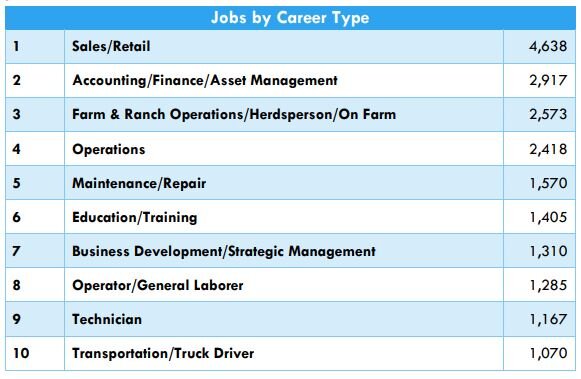Agriculture Job Outlook 2021
Top 10 career types posted on AgCareers.com in 2019.
The U.S. Bureau of Labor Statistics updated their Occupational Outlook Handbook on September 1, 2020, which included a list of the 20 fastest growing careers. Among those were several related to food and agriculture.
Statistician – 35% Growth Rate, 2019-2029
While one may not automatically think of a statistician as an agriculture career, there are many employed in the industry. In fact, we interviewed statistician Kimberly McDaniel, who works for the National Agricultural Statistics Service in the Kentucky Field Office a couple years ago (see kyfoodandfarm.com).
Statisticians collect and analyze data to help solve problems, and statistics are needed for many aspects of business. Numbers, such as crop production, input costs, and farmer demographics help the government provide programs to help the largest number of agricultural producers.
Statisticians typically need at least a master’s degree in mathematics or statistics. The median annual wage for a statistician in 2019 was $91,160.
Similar jobs with high levels of job growth:
Actuaries use mathematics, statistics, and financial theory to analyze the financial costs of risk and uncertainty. Median wage - $108,350
Economists collect and analyze data, research trends, and evaluate economic issues for resources, goods, and services. Median wage - $105,020
Market research analysts study market conditions to examine potential sales of a product or service. Media wage - $63,790
Operations research analysts use advanced mathematical and analytical methods to help solve complex issues. Media wage - $84,810
Forest Fire Inspectors and Prevention Specialists – 24% Growth Rate, 2019 – 2029
Forest fire inspectors enforce fire regulations, inspect forest for fire hazards and recommend forest fire prevention or control measures. May report forest fires and weather conditions. They also relay messages about emergencies, accidents, locations of crew and personnel, and fire hazard conditions. Other jobs in this career include conducting wildland firefighter training.
Because fire inspectors and investigators typically have previous work experience as a firefighter, many have completed a postsecondary educational program for emergency medical technicians (EMTs). Some employers prefer candidates with a 2- or 4-year degree in fire science, engineering, or chemistry. For those candidates interested in becoming forest fire inspectors and prevention specialists, a high school diploma or equivalent typically is required. Training requirements vary by state, but programs usually include instruction in a classroom setting in addition to on-the-job training.
The median annual wage was reported as $45,270 to $56,130 from different sources. See this link for additional information.
Restaurant Cooks – 23% Growth Rate, 2019 – 2029
It will be interesting to see if job growth forecasts will change due to the pandemic, but restaurant kitchen positions had been previously growing. Most cooks learn their skills through on-the-job training and related work experience, but some cooks attend culinary school. The median annual salary for a restaurant cook is $27,790.
Animal Care and Service Workers – 22% Growth Rate, 2019 – 2029
Animal care and service workers are employed in a variety of settings, including farms, kennels, zoos, stables, animal shelters, pet stores, veterinary clinics, and aquariums. Some parts of the job may be physically or emotionally demanding, and workers risk injury when caring for animals.
Animal care and service workers typically have a high school diploma or equivalent and learn the occupation on the job. Many employers prefer to hire candidates who have experience working with animals. Median annual wage in 2019 was $24,780.
Similar jobs with high levels of growth:
Veterinarians care for the health of animals and work to protect public health. Veterinarians must have a Doctor of Veterinary Medicine degree from an accredited veterinary college, as well as a state license. Most programs generally take 4 years to complete after a bachelor’s degree has been earned. Median wage - $95,460
Veterinary technologists and technicians do medical tests that help diagnose animals’ injuries and illnesses. They must complete a postsecondary program in veterinary technology. Technologists usually need a 4-year bachelor’s degree, and technicians need a 2-year associate’s degree. Typically, both technologists and technicians must take a credentialing exam and become registered, licensed, or certified, depending on the requirements of the state in which they work. Median wage - $35,320
Veterinary assistants and laboratory animal caretakers handle routine animal care and help scientists, veterinarians, and others with their daily tasks. Most veterinary assistants and laboratory animal caretakers have a high school diploma or equivalent and learn the occupation on the job. Median wage – $28,590
Also see our interview with Louisville Zoo zookeeper Beka Vaile.

